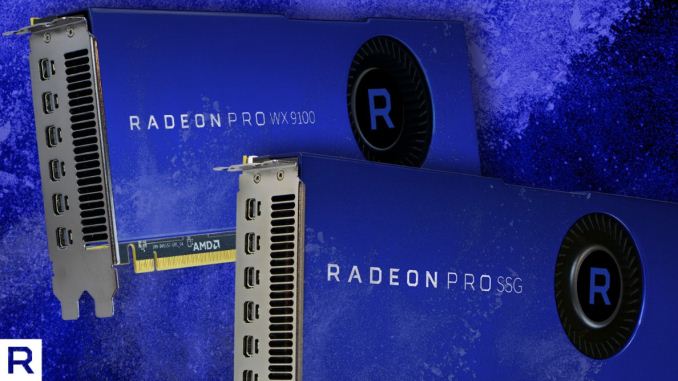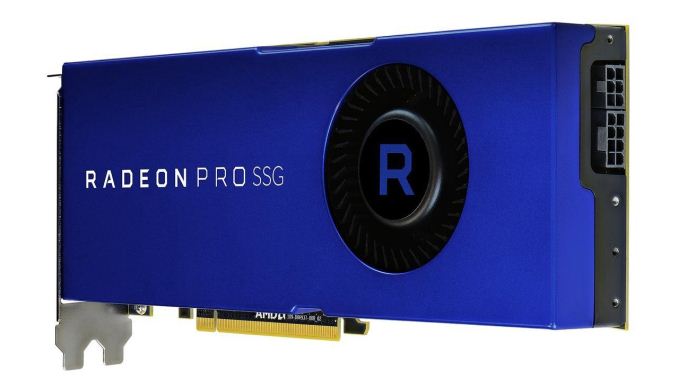Now (and Almost) Shipping: Radeon Pro WX 9100 and SSG, with New Vega Pro Drivers
by Nate Oh on October 26, 2017 3:00 PM EST- Posted in
- GPUs
- AMD
- RTG
- Vega
- Radeon Pro

Last week, AMD quietly announced the availability of the Radeon Pro WX 9100 and Radeon Pro Solid State Graphics (SSG), the former card shipping now and the latter shipping soon. Alongside the cards are two new Radeon Pro Software drivers for Pro WX 9100, Pro SSG, and Radeon Vega Frontier Edition. The major driver, Radeon Pro Software Crimson ReLive Edition 17.10, is actually the same Vega Pro driver previewed and announced earlier this summer, now bringing full Driver Options and more to the WX 9100 and Vega Frontier Edition. The other driver, 17.10.1, is the inaugural driver for the Radeon Pro SSG (Vega), and it is not clear if it includes 17.10’s new features.
Update (10/26/17): A few hours after the publication of this article, AMD released Radeon Pro Software Enterprise Driver 17.Q4, a unified driver update that includes support for the WX 9100, SSG, and Vega Frontier Edition. This release is now the latest driver for all three, and at this time, their workstation driver download links lead to 17.Q4. AMD later confirmed that Vega SSGs began shipping during the week of 10/16.
Prosumers and close readers may remember AMD’s SIGGRAPH 2017 Capsaicin event, and at the time they slated the WX 9100 and SSG for release on September 13th, at $2199 MSRP and $6999 MSRP respectively. While it is late, the products are finally available at HPC/professional outlets and traditional retailers. SabrePC is offering the Pro WX 9100 at $1549 and Pro SSG at $4599, in-line with SEP prices, while Newegg has the Pro WX 9100 at $1599 and the Pro SSG, due for release on October 31st, at $6999. As a note of clarification, lowered prices from retailers reflect the Suggested Etail Price (SEP), which is seen in multiple professional products from both vendors; MSRP reflects the cost if purchased through a brick-and-mortar distribution model. To be clear, the WX 9100 has already started shipping late in Q3, as noted in AMD's Q3 2017 earnings call; as for the SSG, it appears to be shipping before the end of the month, with SabrePC citing stock but a 3 - 5 day period before shipping availability, as well as Newegg's October 31st release date.
For the WX 9100, this slots in at the top of the AMD workstation video card stack, joining the Polaris based cards announced last year, as well as the entry-level Polaris 12 based cards, first introduced as the RX 550. For the SSG (Vega), this release has finally productized the prototype SSG, although swapping Fiji out for Vega. With 2TB M.2 NVMe SSG + 16GB ECC High Bandwidth Cache (HBC) of total video memory, the Radeon Pro SSG allows for significantly larger workset sizes. As opposed to the beta SSG, the Radeon Pro SSG is now able to coordinate the video memory with Vega’s HBCC, a feature that was not present in Fiji.
| AMD Workstation Card Specification Comparison | |||||
| Radeon Pro SSG (Vega) |
Radeon Pro WX 9100 |
Radeon Vega Frontier Edition |
|||
| Stream Processors | 4096 | ||||
| ROPs | 64 | ||||
| Boost Clock | 1500MHz | 1500MHz | 1600MHz | ||
| Memory Clock | 1.89Gbps HBM2 | ||||
| Memory Bus Width | 2048-bit | ||||
| Single Precision | 12.3 TFLOPS | 12.3 TFLOPS | 13.1 TFLOPS | ||
| Half Precision | 24.6 TFLOPS | 24.6 TFLOPS | 26.2 TFLOPS | ||
| VRAM | 2TB SSG + 16GB HBC ECC | 16GB HBC ECC | 16GB HBC | ||
| TDP | <300W | <250W | Air: 300W Liquid: 375W |
||
| Power Connectors | 1x 6pin, 1x 8pin | 1x 6pin, 1x 8pin | 2x 8pin | ||
| GPU | Vega 10 | ||||
| Architecture | GCN 5 (Vega) | ||||
| Manufacturing Process | GlobalFoundries 14nm | ||||
| Launch Date | ~10/2017 | 6/2017 | |||
| Launch Price (MSRP) | $6999 | $2199 | Air: $999 Liquid: $1499 |
||
In terms of drivers, 17.10 brings full functionality of “Driver Options,” although limited to Windows 10. Essentially, Driver Options allows Radeon Pro Software to swap between up to two gaming drivers (Radeon Software for Radeon Pro) and one professional driver (Radeon Pro Software) without a reboot. The installation process requires the Custom Install option to be selected, and AMD has provided a user guide outlining the setup of Driver Options. Alongside the driver, AMD had also released updates to the Radeon ProRender plug-ins, centered around performance and new features.
17.10 also fixes 10-bit display anomalies in display results and Blu-ray playback issues on PowerDVD after switching to Game Mode, as well as infrequent hangs during wake from sleep or resume states, and TDRs during sleep and resume when instant replay is enabled.
As for 17.10.1, the Radeon Pro SSG launch driver is only available for Windows 10 (64 bit), with an SSG API User Manual available online. Both drivers state that the WX 9100 and SSG do not support Multi-GPU Large Surface, AMD CrossFire Pro, Display Overlap, and Serial Digital Interface. Additionally, the WX 9100 does not support Pack Pixel with 10-bit support, and the SSG does not support Bus Active Chip Off.
For more driver details, see the 17.10 and 17.10.1 release notes, as well as AMD’s workstation graphics driver index.
Source: AMD











14 Comments
View All Comments
Tams80 - Sunday, October 29, 2017 - link
The comments here wouldn't be the same without ddriver.Long posts written to look like they are knowledgeable, but rarely so. Top entertainment.
Kevin G - Sunday, October 29, 2017 - link
I'm not entirely sure there is a raw latency win either. I think AMD went this route as they knew it would actually work in the end. PCIe devices are permitted to communicate directly with each other. At the hardware level it is conceptually possible for brand spanking new Intel Optane 900p drive to be used directly by the Radeon SSG for cache storage. The catch is the software side which would require hypervisor, OS and driver (both Intel and AMD) support for it all to work. This should conceptually be cheaper and faster (the entire PCIe 16x bus can be used on the Radeon SSG for transfer).edzieba - Friday, October 27, 2017 - link
The Radeon SSG uses a Broadcom PEX8747 PCIe switching chip, to take the 16x link from the GPU and split it into an 8x link (then bifurcated to 2 4x links to the two internal m.2 drives) and a 16x for the card-edge connector (bandwidth-limited to 8x when the drives are in use).If you instead put the GPU in one slot and an 8x SSD host card in another, you could use DMA to get the same result. Or a host card with a 16x link (4 x4 SSDs rather than 2) for greater performance. Both Nvidia and AMD cards can already use DMA, and have been able to for many, many years.
Having the m2 drives on the same card means you pay extra for an expensive lane-switching chip, and only get any actual benefit if you are limited by physical volume of your chassis from adding the extra host cards.
Kevin G - Sunday, October 29, 2017 - link
By putting them on board, AMD does have the option of hiding them from the host system for other purposes and configurations. Using NVMe drives as you describe is technically possible but requires all the parties involve to behave as expected, including the user who would have to configure the NVMe drive to be a Radeon SSG cache. Insert issue here where a scientist assigns the nice NVMe boot drive to a Radeon SSG cache and nukes the system install.You're also erroneous on the PEX8747 chip. It has 48 lanes total, which 16 can go do the host system, 16 to the Radeon GPU which leaves 16 lanes available for SSDs. This chip would only be a bottleneck if the Radeon GPU was able to saturate its link to the host system and simultaneously needed access to the on board SSDs.